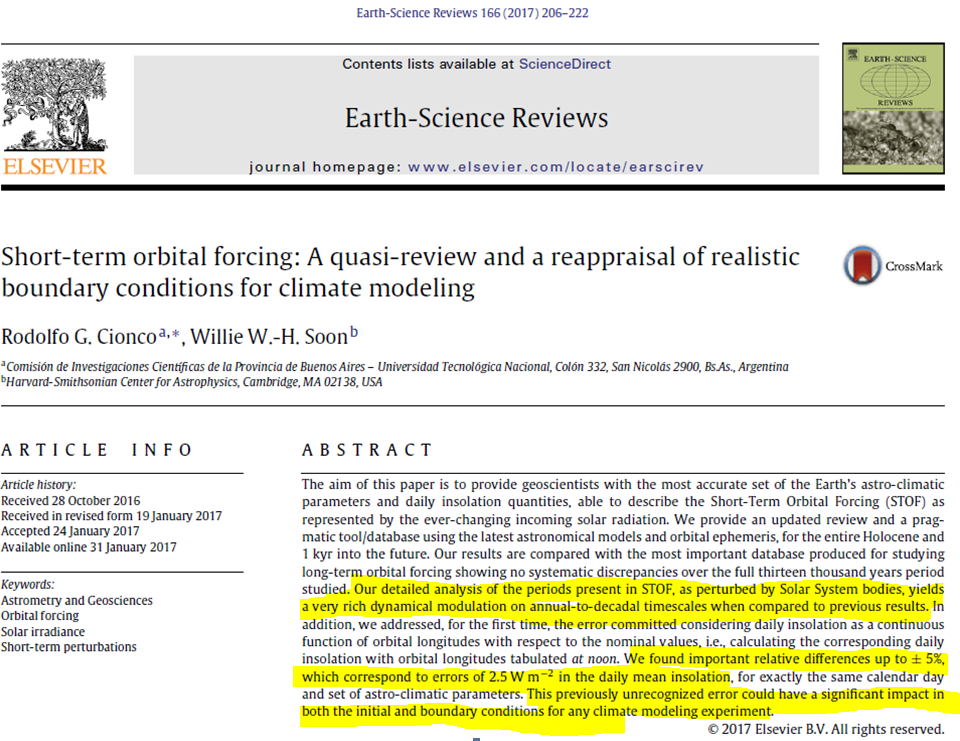A new paper is out by Rodolfo G. Cionco and Willie W. H. Soon: “Short Term Orbital Forcing (STOF): A quasi-review and a reappraisal of realistic boundary conditions for climate modeling“.
It suggests that climate models have neglected to take surrounding astro-climatic parameters correctly into account, and thus their output results are likely even less reliable.

The abstract above states that the two authors found “important relative differences of up to +- 5%, which correspond to 2.5 W/sqm in the daily mean insolation“. They conclude: “this previously unrecognized error could have a significant impact in initial and boundary conditions for any climate modeling experiment.”
Willie Soon, a Harvard astrophysicist and skeptic of AGW science, wrote in an email:
To our best understanding, this new insolation calculation should supersede/replace the previous outputs provided by Berger & Loutre (1991) and Laskar et al. (2004) and their related publications especially since all these previous calculations/databases have not accounted for the modulating effects from STOF. “
The scientists summarize in the paper that the error “could spread and propagate with time especially when intra-annual insolation quantities are required” and that “the sensitivity of initial climate conditions to these differences should be addressed“.
In other words: it’s back (again) to the drawing board for the beleaguered climate modelers.
The full paper can be downloaded from: https://www.researchgate.net/profile/Rodolfo_Cionco All the supplementary data, both programs and input databases are available here: https://1drv.ms/f/s!Apqs4Ax-5XDXggROueG7s6FC8bqs.





So the identified solar forcing modeling errors are 2.5 W m-2.
The IPCC (TAR) has claimed that the total forcing attributed to solar factors since 1750 is 0.3 W m-2. This means that errors in our estimates of solar forcing are more than 8 times greater than the alleged forcing itself.
In other words, our models of the Sun’s effect on climate are bunk.
Here’s another paper that identifies errors in our estimates of solar zenith angle with “spurious variations” of up to 30 W m-2.
And the science is…settled?
Zhou et al., 2015
http://onlinelibrary.wiley.com/doi/10.1002/2015GL063239/abstract
“Annual incident solar radiation at the top of atmosphere (TOA) should be independent of longitudes. However, in many Coupled Model Intercomparison Project phase 5 (CMIP5) models, we find that the incident radiation exhibited zonal oscillations, with up to 30 W/m2 of spurious variations. This feature can affect the interpretation of regional climate and diurnal variation of CMIP5 results. This oscillation is also found in the Community Earth System Model (CESM). We show that this feature is caused by temporal sampling errors in the calculation of the solar zenith angle. The sampling error can cause zonal oscillations of surface clear-sky net shortwave radiation of about 3 W/m2 when an hourly radiation time step is used, and 24 W/m2 when a 3-hour radiation time step is used.”
Humm. Just about the same size as the supposed CO2 forcing increase. Is this a long term error, or short term?
“So the identified solar forcing modeling errors are 2.5 W m-2. ”
no. They are up to 5% (which would not be a huge error anyway).
Most of the time the errors are much smaller, for example 0.2%. Check figures 16 and 17 (really horrible figures, by the way).
https://www.researchgate.net/profile/Rodolfo_Cionco
Not just the solar forcing itself, but the changes within the spectrum, especially in the UV ranges, needs a lot more study.
Anyone that thinks the spectrum remains constant through solar peaks also needs to go back and start again.
UV spectrum changes makes large differences to penetration of energy into sea water.
Exactly, and depth of absorption by the oceans is wavelength dependent.
A change in UV spectrum means that energy is being absorbed at different depths, and this could have an impact on the time taken for the energy so absorbed to surface (impacting upon SST), or on the energy contained in any given oceanic currents.
In a complex 3D environment, it does not automatically follow that all watts are born equal, and have equal impact.
And let’s not forget the abundance of sea life, down to microscopic sizes, and the many chemical in water than can and do absorb solar energy of all frequencies.
LWIR DOESN’T effect ocean energy, because it barely penetrates the surface. No warming, just surface evaporation.
And that surface evaporation actually COOLS the top 1mm or so by some 0.3ºC because latent heat is dragged from the near surface water and atmosphere during that evaporation.
Bingo! Solar wave flux of very long residence UV and visible light entering the oceans has a residence time thousands of times greater them LWIR CO2 variation. Thus over years said flux can add or subtract immensely more energy from Earth’s the energy in Earth’s land, ocean atmosphere.
The “science” is settled?
No, not really.
http://www.breitbart.com/tech/2017/03/29/j-scott-armstrong-fraction-1-papers-scientific-journals-follow-scientific-method/
But they do provide the most committed advocacy your tax dollars can buy.
Thanks Pierre for a very interesting read.
Though it may take till the weekend to fully digest all the implication that it says.
Here is some more on Dr Soon’s work.
Climate “Science” on Trial; Cherry Picking Locations to Manufacture Warming
https://co2islife.wordpress.com/2017/02/18/a-tale-of-two-cities-cherry-picking-locations-to-manufacture-warming/
[…] Important study: Waste heat is a major source of national warming, significantly pollutes climatic record. Feet of clay: The official errors that exaggerated global warming. Feet of clay: The official errors that exaggerated global warming–part 2. Feet of clay: The official errors that exaggerated global warming – part 3. The Difference Between Energy, Work and Power – and Why it Matters to Climate Prediction. New NASA Data Blow Gaping Hole In Global Warming Alarmism. Harvard Physicist/New Study Say Daily Insolation Errors Not Accounted For! […]